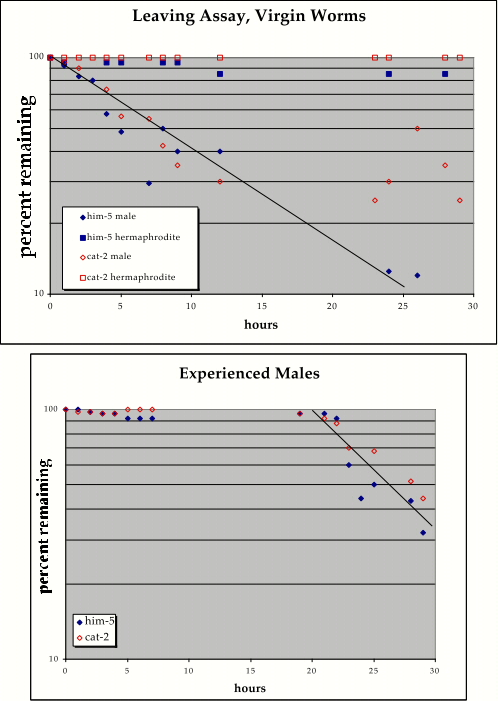
Worm Breeder's Gazette 16(1): 56 (October 1, 1999)
These abstracts should not be cited in bibliographies. Material contained herein should be treated as personal communication and should be cited as such only with the consent of the author.
Albert Einstein College of Medicine, 1300 Morris Park Ave., Bronx, NY 10461
All sexual animals must interpret stimuli necessary for individual survival such as food along with those required for survival of the species such as sex. This is achieved, in part, by behavioral dimorphisms between the sexes. We are studying a sexually dimorphic behavior in C. elegans in order to gain insight into how the nervous system might integrate appetitive stimuli. It is well known that individual males cultured on a bacterial lawn in the absence of hermaphrodites will leave the food source, presumably in search of a mate. In order to study this behavior, we have developed a simple "leaving" assay. Single animals are placed on a small bacterial lawn in the center of a 9cm plate and monitored at several intervals for their position on the plate. A worm that has wandered as far as 3.5 cm from the plate-center, or off the agar entirely, is scored as a "leaver." When we tested him-5(e1490) virgin animals, about 80% of males had left compared to about 5% of hermaphrodites demonstrating a dramatic behavioral dimorphism.
A simple model for interpreting "leaving" behavior is that leaving occurs stochastically, characterized by a probability of leaving per hour (PL). A stochastic behavior with constant PL would predict an exponential decay of worms on the bacterial lawn. This is what we oberved with PL males =0.09/hr compared to PL hermaphrodites =0.006/hr (Figure 1). The data are consistent with PL being constant over time: males are in a single behavioral state throughout the duration of the assay.
When five paralyzed hermaphrodites were plated along with single him-5 test males, PL was changed to that of him-5 hermaphrodites. In contrast, when five paralyzed males were co-plated with single him-5 males, PL was not dramatically altered, suggesting that a sex-specific cue prevents leaving and that mere contact with other worms is insufficient to do so. One might think that a mated male would turn his attention to food. Does mating make males refractory to leaving? Males co-plated with hermaphrodites for 21 hours did not have a significantly altered PL when the hermaphrodites were removed suggesting that mating experience does not alter a male's behavioral state. Back extrapolation showed that upon hermaphrodite removal, males proceeded to leave immediately with PL comparable to that of virgin males (Figure 2). These data suggest both that males do not enter an extended refractory state and that the putative hermaphrodite-derived cue is short-lived.
The removal of hermaphrodites co-plated with males results in a dramatic behavioral modification. Dopamine has been implicated in behavioral modulation in response to food (B. Sawin, PhD thesis, MIT, 1996) and males have sex-specific dopaminergic neurons, therefore we wondered whether dopamine-deficient males might have an altered response either to the presence or removal of hermaphrodites. While PL cat-2(e1112);him-5(e1490) males is lower than that of him-5 males (=0.06/hr), they remained in the presence of hermaphrodites and their response to hermaphrodite removal was not significanlty altered.
We are interested in determining what parts of the male neuroanatomy and what genes are responsible for the sex-specific leaving behavior to better understand the fulcrum mediating sex-specific response to appetitive stimuli.
